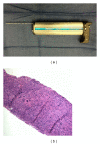Multidisciplinary management of soft tissue sarcoma
- PMID: 23983648
- PMCID: PMC3745982
- DOI: 10.1155/2013/852462
Multidisciplinary management of soft tissue sarcoma
Abstract
Soft tissue sarcoma is a rare malignancy, with approximately 11,000 cases per year encountered in the United States. It is primarily encountered in adults but can affect patients of any age. There are many histologic subtypes and the malignancy can be low or high grade. Appropriate staging work up includes a physical exam, advanced imaging, and a carefully planned biopsy. This information is then used to guide the discussion of definitive treatment of the tumor which typically involves surgical resection with a negative margin in addition to neoadjuvant or adjuvant external beam radiation. Advances in imaging and radiation therapy have made limb salvage surgery the standard of care, with local control rates greater than 90% in most modern series. Currently, the role of chemotherapy is not well defined and this treatment is typically reserved for patients with metastatic or recurrent disease and for certain histologic subtypes. The goal of this paper is to review the current state of the art in multidisciplinary management of soft tissue sarcoma.
Figures



References
-
- Cormier JN, Pollock RE. Soft tissue sarcomas. A Cancer Journal for Clinicians. 2004;54(2):94–109. - PubMed
-
- Jemal A, Murray T, Ward E, et al. Cancer statistics, 2005. A Cancer Journal for Clinicians. 2005;55(1):10–30. - PubMed
-
- Cancer Facts and Figures 2012. Atlanta, Ga, USA: American Cancer Society; 2012.
-
- Wibmer C, Leithner A, Zielonke N, Sperl M, Windhager R. Increasing incidence rates of soft tissue sarcomas? A population-based epidemiologic study and literature review. Annals of Oncology. 2009;21(5):1106–1111. - PubMed
-
- Musculoskeletal Tumors 2. Rosemont, Ill, USA: American Academy of Orthopaedic Surgeons; 2007.
Publication types
MeSH terms
LinkOut - more resources
Full Text Sources
Other Literature Sources
Medical

